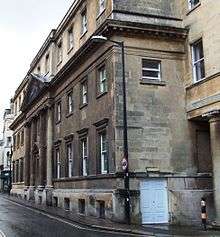Royal National Hospital for Rheumatic Diseases
| Royal National Hospital for Rheumatic Diseases | |
|---|---|
| Royal United Hospitals Bath NHS Foundation Trust | |
 Royal National Hospital for Rheumatic Diseases | |
 Shown in Somerset | |
| Geography | |
| Location | Bath, Somerset, England |
| Coordinates | 51°22′55″N 2°21′41″W / 51.38194°N 2.36139°WCoordinates: 51°22′55″N 2°21′41″W / 51.38194°N 2.36139°W |
| Organisation | |
| Care system | NHS |
| Hospital type | Specialist |
| Services | |
| Emergency department | No |
| Speciality | Rheumatology |
| History | |
| Founded | 1742 |
| Links | |
| Website | http://www.rnhrd.nhs.uk/ |
| Lists | Hospitals in England |
The Royal National Hospital for Rheumatic Diseases is a small, specialist NHS hospital in the centre of Bath. Since 2015 it is run by the Royal United Hospitals Bath NHS Foundation Trust. The building frontage uses Royal Mineral Water Hospital, a previous name. Still known locally as "The Min", it is officially the Royal National Hospital for Rheumatic Diseases. It is a Grade II* listed building.
History
From the 16th century the needs of the "deserving poor" who came to take the healing waters of the Roman Baths were recognised and an act of 1597 gave them the right to free use of the waters.[1] This attracted beggars and, although the act was repealed in 1714, large numbers of people were still attracted to the city and St John's Hospital was only accessible to local residents. Plans were suggested for a hospital to receive them in 1716 with supporters which included Lady Elizabeth Hastings, Henry Hoare, Joseph Jekyll, William Oliver and Beau Nash.[2]
The hospital was founded in 1738 as The Mineral Water Hospital.[3] It provided care for the impoverished sick who were attracted to Bath because of the supposed healing properties of the mineral water from the spa. The original building, which was designed by John Wood the Elder, was built with Bath stone donated by Ralph Allen and completed in 1742.[3] It was later enlarged, firstly in 1793 by the addition of an attic storey and later in 1860 by a second building erected on the west side of the earlier edifice.[3][4] There is a fine pediment, in Bath stone, on the 1860 building depicting the parable of the Good Samaritan.[3]
In 1993, it became an NHS Foundation Trust, specialising in Rheumatic Disease and Rehabilitation, which received a 3 star rating in 2005. The hospital had a large brain injury rehabilitation service with separate units for adults, adolescents and children; this service closed in March 2013 as a result of financial pressures.[5]
The hospital was named by the Health Service Journal as the best acute specialist trust to work for in 2015. At that time it had 208 full-time equivalent staff and a sickness absence rate of 3.18%. 91% of staff recommend it as a place for treatment and 79% recommended it as a place to work.[6]
It was announced in January 2015 that the Royal National Hospital for Rheumatic Diseases NHS Foundation Trust would be taken over by Royal United Hospitals Bath NHS Foundation Trust, after financial debts had built up toward £2 million.[7][8] During 2015 and 2016 some services were transferred to the Royal United Hospital (RUH), including endoscopy and children's services.[9] It is planned that the last services will be transferred to the RUH by 2018, and the site sold.[10]
Services
The hospital provides local rheumatology services, and also has specialist clinics and services which attract referrals from a national population. Specialist rheumatology clinics include connective tissue disease, ankylosing spondylitis, osteoporosis, and Pagets Disease. It also houses the Bath Centre for Pain Services, which provides psychologically focused treatment for adults, young people and children with chronic pain and is the base for both adult and paediatric services for chronic fatigue syndrome.[11]
The hospital possesses a number of interesting oil paintings, in particular a picture of Dr Oliver and Mr Peirce examining three patients in 1741.[12]
See also
References
- ↑ "Royal National Hospital for Rheumatic Diseases". Bath Heritage. Retrieved 13 January 2013.
- ↑ Falconer, Randle (1888). History of the Royal Mineral Water Hospital, Bath. Bath: Royal Mineral Water Hospital. p. 11.
- 1 2 3 4 Historic England. "Royal National Hospital for Rheumatic Diseases and Royal Mineral Water Hospital, with railings (Grade II*) (1395448)". National Heritage List for England. Retrieved 25 July 2013.
- ↑ Historic England. "Royal National Hospital for Rheumatic Diseases (443857)". Images of England. Retrieved 24 June 2006.
- ↑ Murray, Kate (26 March 2013). "NHS brain injury services cuts are 'heartbreaking', say staff". Guardian. Retrieved 28 March 2013.
- ↑ "HSJ reveals the best places to work in 2015". Health Service Journal. 7 July 2015. Retrieved 23 September 2015.
- ↑ "Takeover at Bath Royal National Hospital for Rheumatic Diseases". BBC News. 28 January 2015. Retrieved 31 January 2015.
- ↑ Amanda Cameron (28 January 2015). "The Min hospital in Bath finally comes under the wing of the city's Royal United Hospital". Bath Chronicle. Archived from the original on 25 September 2015. Retrieved 21 September 2015.
- ↑ "Contact us". Royal National Hospital for Rheumatic Diseases. Retrieved 28 December 2017.
- ↑ Crawley, James (20 March 2017). "Student accommodation? A new hotel? The Min in central Bath has been put up for sale". Bath Chronicle. Archived from the original on 20 March 2017. Retrieved 20 March 2017.
- ↑ "Bath Centre for Fatigue Services". NHS Networks. Retrieved 13 September 2018.
- ↑ "An eighteenth century consultation". Medical Heritage of Great Britain. Retrieved 24 June 2006.